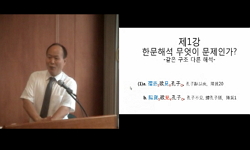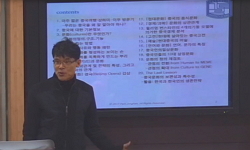瓦當은 건축물 구성의 일부를 이루는 部材라는 실용적 성격을 가지고 있는 것이면서 동시에 건축물에 장식 효과를 주는 예술품이라는 성격을 갖는 매우 중요한 건축물의 한 요소이다. 중국...
http://chineseinput.net/에서 pinyin(병음)방식으로 중국어를 변환할 수 있습니다.
변환된 중국어를 복사하여 사용하시면 됩니다.
- 中文 을 입력하시려면 zhongwen을 입력하시고 space를누르시면됩니다.
- 北京 을 입력하시려면 beijing을 입력하시고 space를 누르시면 됩니다.
https://www.riss.kr/link?id=T9508076
- 저자
-
발행사항
서울 : 弘益大學校 敎育大學院, 2004
-
학위논문사항
학위논문(석사)-- 홍익대학교 교육대학원: 교육학과 미술교육전공 2004. 8
-
발행연도
2004
-
작성언어
한국어
- 주제어
-
KDC
631 판사항(4)
-
DDC
745.44952 판사항(21)
-
발행국(도시)
서울
-
형태사항
ⅲ, 61p. : 삽도 ; 26cm.
-
일반주기명
참고문헌: p. 56-58
- 소장기관
-
0
상세조회 -
0
다운로드
부가정보
국문 초록 (Abstract)
瓦當은 건축물 구성의 일부를 이루는 部材라는 실용적 성격을 가지고 있는 것이면서 동시에 건축물에 장식 효과를 주는 예술품이라는 성격을 갖는 매우 중요한 건축물의 한 요소이다. 중국에서는 瓦當 연구의 중요성이 일찍이 인정되어 北宋시기부터 오늘날에 이르기까지 여러 분야에서 瓦當의 연구가 활발히 진행되고 있다. 瓦當의 연구는 건축사와 미술사 분야에 한정되지 않고 考古學과 古文字學 분야, 나아가서는 사회사, 경제사, 정치사에 이르기까지 다양한 분야에서 이루어진다. 그러나 우리나라에서는 瓦當의 연구가 아직까지는 매우 미진하다.
본 논문은 이미 활발히 진행되고 있는 중국에서의 瓦當 연구를 바탕으로, 중국에서 전래되어 독특한 모습으로 발전한 우리나라 瓦當의 연구를 심화시키는데 이바지하고자 하는 목적에서 비롯되었다. 이를 위해 우선 본 논문에서는 중국에서 발간된 瓦當 연구 결과들을 수집하여 중국 고대 瓦當 紋樣을 중국 고대의 건축 문화와 관련시키면서, 그것이 지니고 있는 역사적 성격을 규명해보고, 나아가 瓦當 紋樣의 예술적 가치를 분석하는 연구를 하였다.
중국의 瓦當 紋樣은 고대에서 시작해 明, 淸에 이르기까지 끊임없이 발전하였고 또 우리나라, 일본의 고대 건축 예술에까지 영향을 미친 역사적 성격을 가지고 있으므로, 연구 가능 대상의 범위가 매우 광범위하다. 본 논문에서는 瓦當 역사의 초창기인 西周부터 瓦當 예술의 융성기인 漢代까지를 중국 고대 瓦當 紋樣 연구의 연구 범위로 한정하였으며 平瓦當과 圓瓦當 가운데 圓瓦當만으로 제한하였다.
이상과 같은 구도로 이루어진 연구의 결과, 드러난 주요 결론은 다음과 같다.
첫째, 瓦當은 西周기인 초기에는 단순히 비바람의 침식으로부터 서까래와 처마를 보호해주어, 건축물의 수명을 연장시켜 주는 작용을 하는 실용품이었다.
둘째, 瓦當 紋樣은 시대에 따라 도상과 도안 등의 장식 문양이 다채롭게 변화한다. 이 사실은 중국 고대 瓦當 紋樣이 독특한 시대성을 가지고 있다는 것을 알려 준다. 특히 文字瓦當에는 그 시대의 정치, 경제, 문화, 종교, 윤리 등을 엿볼 수 있는 내용들이 나타나 있어 역사학, 고고학, 문헌학 등의 여러 학문 분야와 관련하여 중요한 연구 가치를 지닌다.
셋째, 중국 고대 瓦當 紋樣은 작은 반원형과 원형의 공간 내에 풍부한 상상력과 다양한 창작 수법으로 뛰어난 결구미, 조형미와 장식미 등의 예술성을 보여준다. 이런 중국 고대 瓦當 紋樣의 예술성에서 우리는 여러 가지 학술적인 의미를 찾아 낼 수 있을 뿐만 아니라, 篆刻, 디자인, 복식, 공예 등 현대의 다양한 예술 분야에서 이용될 수 있는 실천적 가치까지 찾아낼 수 있다.
다국어 초록 (Multilingual Abstract)
A roof tile-end is a very important architectural component that has not only practical nature as a basic structural material of construction but also artistic quality imparting ornamental effect to buildings. Since the ancient Chinese people had alre...
A roof tile-end is a very important architectural component that has not only practical nature as a basic structural material of construction but also artistic quality imparting ornamental effect to buildings. Since the ancient Chinese people had already acknowledged the significance of studying tile-ends, they have encouraged it actively in many fields especially from Song dynasty to the present. The studies of tile-end are now conducting in such various areas even as social, economic and political history as well as archaeology and paleography, not confined to architectural and art history. Nevertheless, unfortunately, it seems to remain still in a germinal stage in Korea.
On the basis of the Chinese studies of tile-end which are under lively discussion, this thesis aims to make contribute to deepening the study of Korean tile-end which has been developed into its own unique style since introduced from China. For this purpose, this thesis attempts to clarify the historical implications of the patterns of the ancient Chinese tile-ends by relating them to the architectural cultures of that times and, then, to analyze the artistic values with researching studies on the patterns of the tile-end published in the ancient China.
The patterns of the Chinese tile-end provides very wide range of possible subjects of investigation. For it had continuously developed until the Ming and Qing dynasty from its beginning in ancient times, historically influencing the ancient architectural arts of Korea and Japan. Thus, in examining the patterns of the ancient Chinese tile-ends, the chronological scope of this thesis is bounded within the period from the Western Zhou Dynasty, the initial stage of the history of tile-ends, to the Han dynasty, the heyday of tile-end art. In addition, it focused solely upon the circular one between the two types of roof tile-ends: the circular and concave one.
The conclusions of this thesis are as follows:
First, during the Western Zhou Dynasty, or in its early days, the tile-end had a mere practical function to extend the expected life span of buildings by protecting the rafters and eaves of them from corrosion of the elements.
Second, the patterns of the tile-end had shown different decorations including icons and designs according to each historical period, which demonstrates their own historicality. Especially, the tile-end with letters is greatly valuable for historical studies, archaeology and philology, in that it condensed such diverse contents covering politics, economics, cultures, religions, and ethics of that time.
Thirdly, the patterns of the ancient chinese tile-end not only displayed a brilliant structure but also reached a high degree of plastic beauty by virtue of rich imagination and diverse creative techniques employed within the small semi-circular and circular space. Thus, we can reasonably say that the aesthetic patterns of this tile-end of ancient China can provide practical values which is applicable to varied fields of contemporary arts such as industrial arts and craftworks, designs, clothings and ornaments and seal engravings as well as their manifold academic meanings.
목차 (Table of Contents)
- 국문초록 = ⅰ
- 목차 = ⅲ
- 서론 = 1
- Ⅰ. 瓦當의 실용적 성격 = 4
- 1. 瓦當의 기원 = 4
- 국문초록 = ⅰ
- 목차 = ⅲ
- 서론 = 1
- Ⅰ. 瓦當의 실용적 성격 = 4
- 1. 瓦當의 기원 = 4
- 2. 瓦當의 각 부위의 명칭 = 6
- 3. 瓦當의 종류 = 7
- Ⅱ. 중국 고대 瓦當 紋樣의 역사적 성격 = 12
- 1. 西周 瓦當 = 12
- 2. 春秋戰國시대 瓦當 = 14
- 3. 秦, 漢代 瓦當 = 18
- Ⅲ. 중국 고대 瓦當 紋樣의 예술적 성격 = 25
- 1. 瓦當 紋樣의 결구미 = 26
- 2. 瓦當 紋樣의 조형미 = 28
- 3. 文字瓦當의 장식미 = 33
- 결론 = 38
- 표목차 = 41
- 참고도판 = 42
- 참고문헌 = 56
- Abstract = 59












